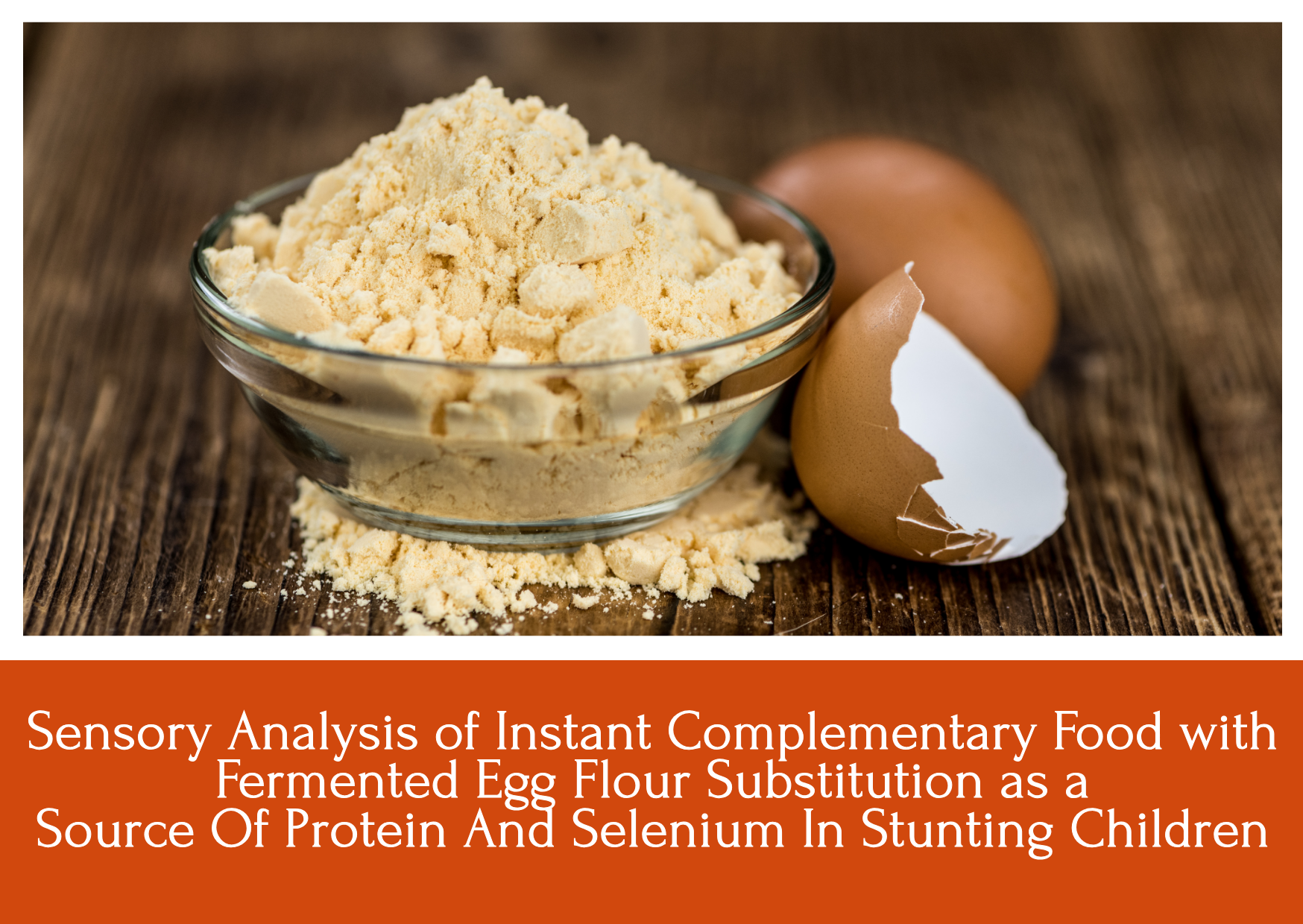EFFECT OF COOKING METHODS AND RICE VARIETY ON THE SENSORY QUALITY AND CONSUMER ACCEPTANCE
Downloads
Akhyar. (2009). Pengaruh proses pratanak terhadap mutu gizi dan indeks glikemik berbagai varietas beras di Indonesia. Tesis. Bogor: Institut Pertanian Bogor. Retrieved from: http:// repository.ipb.ac.id/handle/123456789/41365.
Andarwulan, N., Kusnandar, F & Herawati, D. (2011). Analisis Pangan. Jakarta: Dian Rakyat.
Astawan, M dan T, Wresdiyati. 2004. Sehat Bersama Aneka Serat Pangan Alami. Solo: Tiga Serangkai.
Cagampang, Gloria B, C.M. Perez, dan B.O. Juliano. (1973). A gel consistency test for eating quality of rice. Journal of the Science of Food and Agriculture 24 (12),: 1589–1594. doi:
1002/jsfa.2740241214.
Cameron, D.K., & Wang, Y.J. (2005). A better understanding of factors that aff ect the hardness and stickiness of long-grain rice. Cereal Chem, 82, , 113- 119. doi : 10.1094/CC-82-0113.
Chakkaravarthi, A., Lakshmi, S., Subramanian, R., & Hegde, V.M. (2008). Kinetic of cooking unsoaked and presoaked rice. Journal of Food Engineering, 84, 181-186. doi : 10.1016/j.
jfoodeng.2007.02.061.
Champagne, E. T., Karen L. B., Bryan T. V., Bill, D. W., Anna, M. M., Franklin, E. B., ... David, K. (1997). Eff ects of drying conditions, fi nal moisture content, and degree of milling on rice flavor. Cereal Chemistry, 74 (5), 566–570. doi: 10.1094/CCHEM.1997.74.5.566.
Creed, P. G. & Crowshurt, D. G. (2001). Eff ect of cooking methods and variety on the sensory quality of rice. Food service technology
journal, 1(3"4),: 133 - 140. doi: 10.1046/j.1471 5740.2001.00019.x.
Damardjati, D. S. (1995). Karakteristik sifat standarisasi mutu beras sebagai landasan pengembangan agribisnis dan agroindustri padi di Indonesia. Orasi Pengukuhan Ahli Peneliti Utama. Balai Penelitian Bioteknologi Tanaman Pangan, Bogor.
Febriana A, Rachmawanti D, & Anam C. (2014). Evaluasi kualitas gizi, sifat fungsional, dan sifat sensoris sala lauak dengan variasi tepung beras sebagai alternatif makanan sehat. Jurnal Teknosains Pangan, 3(2), 28-38. Retrieved from: https://jurnal.uns.ac.id/teknosains-pangan/
article/view/4638/4026. .
Gottfried, J. A. (2011). Neurology of sensation and reward. Boca Raton (FL): CRC Press/ Taylor&Francis.
Han, J.A., & Lim, S.T. (2009). Eff ect of presoaking on textural, thermal, and digestive properties of cooked brown rice. Cereal Chemistry, 86, 100- 105. doi: 10.1094/CCHEM-86-1-0100.
Han, S. H., Lee, S.W., & Rhee, C. (2008). Effects of cooking methods on starch hydrolysis kinetics and digestion-resistant fractions of rice, European Food Research and Technology, 227
((5)), :1315-1321. doi: 10.1007/s00217-008-
-6.
Haryadi. 2006. Teknologi Pengolahan Beras. Yogyakarta : Penerbit UGM Press.
Hasbullah, R. (2013). Pengaruh lama perendaman terhadap mutu beras pratanak pada varietas IR 64. Jurnal Keteknikan Pertanian, 27(1). doi :10.19028/jtep.27.1.53-60
Indrasari, S.D. (2011). Pengaruh penyosohan gabah dan pemasakan terhadap kandungan vitamin B beras merah. Jurnal Penelitian Pertanian Tanaman Pangan. 30(3):182-188. Retrieved
from : http://ejurnal.litbang.pertanian.go.id/
index.php/jpptp/article/view/3024/2646
International Rice Research Institute (IRRI). (1991). Rice grain marketing and quality issues. Selected papers from the International Rice Research Conference Seoul, Korea. Philippines:
IRRI.
Jinorose, M., Prachayawarakorn, S., & Soponronnari, S. (2014). A novel image-analysis based approach to evaluate some physicochemical and cooking properties of rice kernels. J .Food Eng, 124, 184-190. doi : 10.1016/j.jfoodeng.2013.08.009
Juliano, B. O. & Perez, C. M. (1983). Major factors affecting cooked milled rice hardness and cooking time. J. Texture Stud, 14, 235-243. doi: 10.1111/j.1745-4603.1983.tb00346.x
Kementerian Pertanian. (2017). Statistik pertanian 2017. Jakarta: Kementan.
Kohlwey DE, Kendall JH, Mohindra RB (1995). Using the physical properties of rice as a guide to formulation. Cereal Foods World 40,
–32.
Lum, M. S. (2017). Physicocemical characteristic of different rice varieties found in Sabah, Malaysia. Transactional on Science and Technology, 4(2). 68-75. Retrieved from : http://tost.unise.org/
pdfs/vol4/no2/4x2x68x75.pdf
Luna, Prima., Heti Herawati., sri Widowati., Aditya B. Prianto. (2015). Pengaruh kandungan amilosa terhadap karakteristik fi sik dan organoleptik nasi instan. Jurnal Penelitian Pascapanen
Penelitian 12 (1), 1-10. doi: 10.21082/jpasca.v12n1.2015.1-10
Lyon, B. G., Champagne, E. T., Vinvard, B. T., & Windham, W. R. (2000). Sensory and instrumental relationships of texture of cooked rice from selected cultivars and postharvest
handling practices. Cereal Chem, 77, 64-69. Doi : 10.1094/CCHEM.2000.77.1.64
Mardiah, Z., Handoko, D. D., Septianingrum, E., & Kusbiantoro, B. (2017). Improvement of red rice eating quality through one-time polishing process and evaluation on itsphenolic and anthocyanin content. International Journal of Agriculture, Forestry and Plantation, 5(6). Retrieved from : http://ijafp.com/wp-content/
uploads/2017/10/AG-9.pdf
Mestres, C., Ribbeyre, F., Pons, B., Fallet, V., & Matencio, F. (2011). Sensory texture of cooked rice is rather linked to chemical than to physical characteristics of raw grain. J Cereal Sci,53, 81-89. doi : 10.1016/j.jcs.2010.10.001
Muchtadi, T.R. dan Sugiono. (1992). Ilmu Pengetahuan Bahan Pangan. Departemen Pendidikan dan Kebudayaan. Direktorat
Jenderal Tinggi Pusat Antar Universitas Pangan dan Gizi. Bogor: Institut Pertanian Bogor.
Patindol, J., Gu X., & Wang, Y.J. (2010). Chemometric analysis of cooked rice texture in relation to starch fi ne structure and leaching
characteristics. Starch-Starke, 62, 188-197. doi: 10.1002/star.200900181
Saleh, M. I., & Meullenet, J. F. (2007). Effect of protein disruption using proteolytic treatment on cooked rice texture properties. J. Texture Stud, 38, 423- 437. doi : 10.1111/j.1745-
2007.00105.x
Soekarto, TS. (1985). Penilaian Organoleptik untuk Industri Pangan dan Hasil Pertanian. Bharata Karya Aksara; Jakarta
Subarna, Suroso, Budijanto S., & Sutrisno. (2017). Pengembangan metode menanak optimum untuk beras varietas Sintanur, IR 64 dan Ciherang. Prosiding Seminar Nasional Teknologi Inovatif
Pasca Panen untuk Pengembangan Industri Berbasis Pertanian. Retrieved from : http:// repository.ipb.ac.id/handle/123456789/26076
Suwannaporn, P., & Linnemann, A.R. (2008). Consumer preferences and buying criteria in rice: a study to identify market strategy for Thailand jasmine rice export. Journal of food product marketing. Vol 14(4):33-53. doi : 10.1080/10454440801986348
Syafutri, M. I., Pratama, F., Syaiful, F., & Faizal, A. (2016). Eff ects of varieties and cooking methods on physical and chemical. Rice Science. 23(5), :282-286. doi : 10.1016/j.rsci.2016.08.006
Tian, Y., Zhao, J., Xie, Z., Wang, J., Xu, X., & Jin, Z. (2014). Eff ect of diff erent pressure-soaking treatments on color, texture, morphology and retrogradation properties of cooked rice. Food
Science and Technology Journal, 55, (368-373). doi: 10.1016/j.lwt.2013.09.020
Wada, M., Tsubone, Y., Hamanhi & Ogata, T. (2006). Evaluation and use of physicochemical properties as index trains for selecting rice
cultivars with extremely high palatability. Jpn. J. Crop Sci, 75, 38-43. doi: 10.1626/jcs.75.38
Winarno, F.G. (2008). Kimia Pangan dan Gizi: Edisi Terbaru. Jakarta.
Wongpornchai, S., Dumri, K., Jongkaewwattana, S., & Siri, B. (2004). Effect of Drying Methode and Storage Time on the Aroma and Milling Quality of Rice (Oryza sativa L.) cv. Khao Dawk Mali
Journal Food Chemistry 87(3) : 407-414.
doi: 10.1016/j.foodchem.2003.12.014
Yadav, R. B., Khatkar, B. S., & Yadav, B. S. (2007). Morphological, physicochemical and cooking properties of some Indian rice (Oryza sativa L.) cultivars. J Agric Technol, 3(2): 203–210. Retrieved from: http://www.ijat-aatsea.com/pdf/Nov_V3_no2_07/5-IJAT2007_14-P%20203-210.pdf
Yamakura, M., Haraguchi, K., Okadome, H., Suzuki, K., Tran, U., Horigane, A.K.,... Ohtsubo, K.(2005). Effects of soaking and high-pressure treatment on the qualities of cooked rice. Journal of Applied Glycoscience, 52, 85e93. doi: 10.5458/jag.52.85
Yang, D.S., Lee, K.S., & Kays, S.J. (2010). Characterization and discrimination of premiumquality, waxy, and black pigmented rise based on odor-active compounds. J. Sci Food Agric, n/a. doi: 10.1002/jsfa.4126. doi: 10.1002/jsfa.4126
Yang, L., Sun, Y.H., Liu, Y., Mao, Q., You, L.M., Hou, J.M., & Ashraf, M.A. (2016). Effect of leached amylose and amylopectin in rice
cooking luquidon texture and structure of cooked rice. Brazilian Archives of Biology and Technology, 59. doi: 10.1590/1678-4324-
Yu, S.F., Ma, Y., & Sun, D.W. (2009). Impact of amylose content on starch retrogradation and textureof cooked milled rice during storage. Journal of Cereal Science, 50,139-144. doi: 10.1016/j.jcs.2009.04.003
- MEDIA GIZI INDONESIA Journal is the copyright owner of all materials published on this website.
- The formal legal provisions for access to digital articles of this electronic journal are subject to the terms of the Creative Commons Attribution-NonCommercial-ShareAlike license (CC BY-NC-SA 4.0), which means that MEDIA GIZI INDONESIA Journal and readers reserve the right to save, transmit media / format, manage in database, maintain, and publish articles as long as it continues to include the name of the Author.
- Printed and published print and electronic manuscripts are open access for educational, research and library purposes. In addition to these objectives, the editorial board shall not be liable for violations of copyright law.


2.png)




















